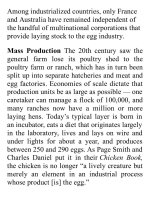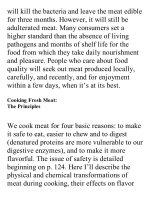On food and cooking the science and lore of the kitchen ( PDFDrive ) 275
Bạn đang xem bản rút gọn của tài liệu. Xem và tải ngay bản đầy đủ của tài liệu tại đây (168.6 KB, 2 trang )
the younger “game hen” or “poussin” even
moreso.
Largelyinreactiontotheimageof
industrialchicken,so-called“freerange”
chickensarenowsoldintheUnitedStates,
butthetermonlymeansthatthebirdshave
accesstoanoutdoorpen.“Roasting”chickens
andcapons(castratedmales)areraisedto
doubleormoretheageofthestandardbroiler,
areheavier,andsohavegiventheirleg
musclesmoreexercise;thecaponmayalsobe
moresucculentthankstotheinfiltrationof
marblingfat.
Turkeys Turkeys are also members of the
sedentary
pheasant
family.Meleagris
gallopavodescendedfromancestorsthatonce
ranged through NorthAmerica andAsia. The
modern colossal turkey dates from 1927–
1930, when a breeder in British Columbia
developed a 40 lb/18 kg bird with oversized
flight and thigh muscles, and breeders in the
U.S. northwest used his stock to perfect the
Broad-BreastedBronze.Thelittle-usedbreast
muscle is tender, mild, and lean; the leg
muscles that support the breast are wellexercised,dark,andflavorful.
Today,industrialfacilitiesproduce14–20
lb/6–9kgbirdsyear-roundin12–18weeks;
somesmallAmericanfarmsextendtheperiod
to24weeks,whilethename-controlled
FrenchBresseturkeyisraisedfor32weeksor
more,confinedandfattenedforthelast
severalweeksoncornandmilk.
Ducks and Squab Ducks and squab are
notableforhavingdark,flavorfulbreastmeat,
abundantly endowed with myoglobin-rich red
muscle fibers, thanks to their ability to fly
hundredsofmilesinadaywithfewstops.The
mostcommonbreedsofduckinChina,much
of Europe, and the United States are
descendentsofthewildgreen-headedmallard,
Anasplatyrhynchos,anaquaticmigratorybird









